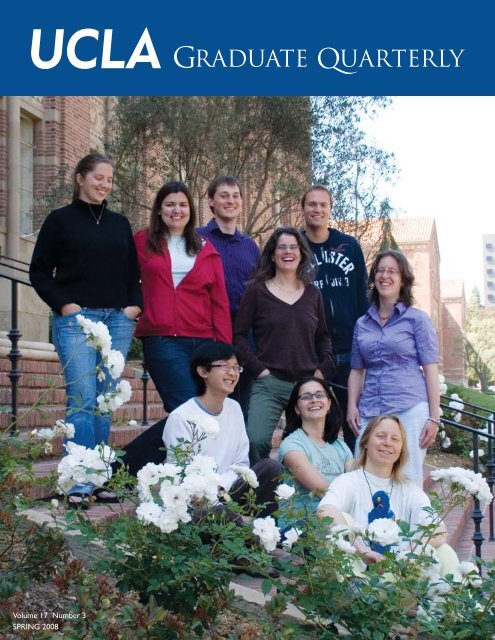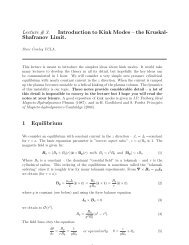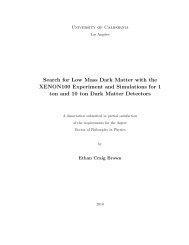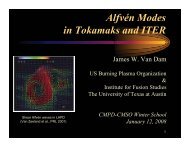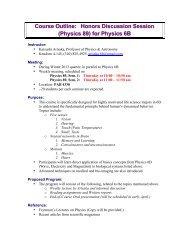Spring 2008 - UCLA Physics & Astronomy
Spring 2008 - UCLA Physics & Astronomy
Spring 2008 - UCLA Physics & Astronomy
You also want an ePaper? Increase the reach of your titles
YUMPU automatically turns print PDFs into web optimized ePapers that Google loves.
Volume 17 Number 3<br />
SPRING <strong>2008</strong><br />
<strong>Spring</strong> <strong>2008</strong> GRADUATE QUARTERLY
Message from the Dean<br />
Dear Graduate Student,<br />
Excellence, collegiality, and diversity: these are the three cornerstones of<br />
the university that Chancellor Gene Block identified in his inauguration<br />
address last month. These three little words express three big ideas, all<br />
of them with important implications for graduate education.<br />
Diversity has always been a primary goal of the Graduate Division,<br />
as we seek out and administer government, foundation, and<br />
private funding that helps us to attract and support members of<br />
underrepresented communities and others who have no family<br />
history of postgraduate education. This is an especially important<br />
task at the graduate level because diversity among today’s graduate<br />
students is the only way to ensure increased diversity among the<br />
faculty of tomorrow.<br />
Collegiality—which the new chancellor defines as a spirit of<br />
discovery and collaboration—is a strong feature of graduate education.<br />
This issue of the Graduate Quarterly includes a portrait of Professor Andrea<br />
Ghez’s research group in the Department of <strong>Physics</strong> and <strong>Astronomy</strong>, an enthusiastically<br />
cooperative and engaged group, centered around and embracing graduate<br />
students and postdoctoral fellows as well. While collaboration is institutionalized in the sciences, it<br />
has also been adopted informally in the humanities, as students gather to share insights about their<br />
professional readings, provide mutual feedback on papers and presentations, and give each other the<br />
personal support it takes to meet the challenges of a graduate career.<br />
Excellence, of course, is the outcome to which we all aspire, as individuals and on behalf of our academic<br />
community. The chancellor correctly points out the degree to which <strong>UCLA</strong>’s excellence depends<br />
on its ability to attract the best students and faculty members—and this inevitably means finding the<br />
money to pay adequate salaries, provide student support, and offer housing alternatives in one of the<br />
nation’s most expensive neighborhoods. Private universities that compete with <strong>UCLA</strong> for research preeminence<br />
have an established track record in raising funds from private foundations and individuals.<br />
This is an arena where <strong>UCLA</strong> must strive to compete on a more equal footing.<br />
More than four years ago now, the Graduate Division stepped forward to document the decline<br />
in financial support for <strong>UCLA</strong> graduate students and the consequences that could have, not only for<br />
<strong>UCLA</strong> or the UC, but for all of California, one of the world’s largest economies and a generator of<br />
many the extraordinary advances that have transformed society in the last few decades. We applaud<br />
the chancellor’s pledge to seek additional philanthropic support for graduate students in the face of<br />
this ongoing crisis.<br />
It has been my pleasure to serve as Vice Chancellor of Graduate Studies with three previous chancellors,<br />
and I feel the surge of energy that always arrives with new leadership. The Graduate Division<br />
stands ready to assist the chancellor in the furtherance of all these goals so close to our hearts.<br />
Claudia Mitchell-Kernan<br />
Vice Chancellor Graduate Studies<br />
Dean, Graduate Division<br />
GRADUATE QUARTERLY <strong>Spring</strong> <strong>2008</strong>
Graduate<br />
Quarterly<br />
a publication of the <strong>UCLA</strong> Graduate Division<br />
Contents<br />
<strong>Spring</strong> <strong>2008</strong><br />
Vice Chancellor Graduate Studies<br />
Dean, Graduate Division<br />
Claudia Mitchell-Kernan<br />
Interim Assistant Vice Chancellor, Graduate Studies<br />
Jim Turner<br />
Associate Dean<br />
Carlos V. Grijalva<br />
Associate Dean<br />
Ross Shideler<br />
Associate Dean<br />
M. Belinda Tucker<br />
Assistant Dean, Academic Initiatives/<br />
Institutional Research & Information Services<br />
Angela James<br />
Assistant Dean, Graduate Admissions/<br />
Student and Academic Affairs<br />
Daniel J. Bennett<br />
Director, Graduate Budgets and Personnel<br />
Edna Joe<br />
Director, Graduate Outreach,<br />
Diversity & Fellowships<br />
Chérie Francis<br />
Director, Graduate Student Support<br />
Ana Lebon<br />
p. 4<br />
p. 22<br />
FeatureS<br />
4 Black Holes<br />
Professor Ghez’s research group in the<br />
Department of <strong>Physics</strong> & <strong>Astronomy</strong><br />
explores the innermost regions of the<br />
Milky Way.<br />
14 Chancellor Block<br />
talks about graduate students<br />
and postdoctoral scholars.<br />
PROFILES<br />
Editor, Designer and Photographer<br />
Mary Watkins<br />
Writer<br />
Jacqueline Tasch<br />
Please send correspondence to:<br />
1237 Murphy Hall, Box 951419<br />
Los Angeles, CA 90095-1419<br />
graduatequarterly@gdnet.ucla.edu<br />
The Graduate Quarterly is published Fall, Winter and <strong>Spring</strong><br />
quarters by the <strong>UCLA</strong> Graduate Division. We welcome suggestions<br />
and comments. Current and archived copies of this<br />
publication are available to view or to download in PDF format<br />
on the Graduate Division web site.<br />
16 Janet Cummings<br />
Public Health<br />
18 Adam Lunceford<br />
Biochemistry<br />
20 Darby Saxbe<br />
Psychology<br />
News<br />
22 Postdoctoral Scholars Honored<br />
25 Graduate Student<br />
Accomplishments<br />
www.gdnet.ucla.edu<br />
Printed on 50% recycled paper (15% post consumer waste).<br />
Printed with soy ink.<br />
Copyright <strong>2008</strong>, Regents of the University of California<br />
On the cover: <strong>Astronomy</strong> Professor<br />
Andrea Ghez’s research group. Back (left to<br />
right) Marshall Perrin, Leo Meyer. Middle<br />
(left to right) Jessica Lu, Quinn Konopacky,<br />
Dr. Ghez, Elise Furlan. Sitting (left to<br />
right): Tuan Do, Sylvana Yelda, Andrea<br />
Stolte. Missing: Betsy Mills<br />
p. 18<br />
<strong>Spring</strong> <strong>2008</strong> GRADUATE QUARTERLY
Black Holes<br />
He I (1.43 microns) and K continuum<br />
(2.29 microns) two-color image of<br />
the central ~10.4 light years taken<br />
with the W. M. Keck II telescope.<br />
The galactic center is ~1 million<br />
times more crowded than the solar<br />
neighborhood. Studying the motions<br />
of these stars tells us a lot about<br />
the supermassive black hole at<br />
the center of the galaxy, which is<br />
indicated by the red arrow.<br />
GRADUATE QUARTERLY <strong>Spring</strong> <strong>2008</strong>
LEFT TO RIGHT: Tuan Do, Leo Meyer, Elise Furlan, Marshall Perrin, Professor Andrea Ghez, Sylvana Yelda, Jessica<br />
Lu, Quinn Konopacky, and Andrea Stolte. Not pictured: Betsy Mills<br />
From the third-graders who talk to Tuan Do and Sylvana Yelda at<br />
<strong>UCLA</strong>’s planetarium to Jessica Lu’s orthodontist, everybody is<br />
curious about black holes. Of course, if they’ve been to the movies,<br />
they probably think they know quite a bit. In film, black holes<br />
are the malicious marauders of the universe, swaggering from galaxy to galaxy<br />
devouring whole planets as a snack before turning a star or two into dinner.<br />
And if people haven’t worried about being sucked into a black hole, they’re<br />
wondering what’s on the other side. In Disney’s The Black Hole (1979), one character<br />
refers to the title player as “that long dark tunnel to nowhere” and another<br />
hopes to steer his spacecraft “straight into what might be the mind of God.”<br />
<strong>Spring</strong> <strong>2008</strong> GRADUATE QUARTERLY
“Black holes kind of mind their own business unless you get really, really close.”<br />
- Professor of <strong>Astronomy</strong> Andrea Ghez<br />
The truth about black holes is perhaps<br />
less dramatic and certainly less menacing.<br />
Rather than sucking everything into them<br />
like some cosmic vacuum cleaner, Professor<br />
of <strong>Astronomy</strong> Andrea Ghez says, black holes<br />
“kind of mind their own business unless you<br />
get really, really close.” In fact, thousands of<br />
stars are safely orbiting the black hole at the<br />
center of the Milky Way, which Professor Ghez<br />
has been studying for more than a decade. And<br />
as it turns out, Tuan, Sylvana, and Jessica are<br />
good people to ask about black holes because<br />
they are part of her research team.<br />
This is one case where the facts may be<br />
more fascinating than the fantasy.<br />
Black holes are both enormously large<br />
and incredibly tiny. The black hole in the<br />
galactic center, for example, is millions<br />
of times the sun’s mass—and all in a superdense<br />
package that is infinitely small.<br />
Because of its density, however, it exerts a<br />
gravitational force so powerful that no light<br />
can escape from an area about 10 times the<br />
radius of the sun, the hole’s event horizon.<br />
For a variety of reasons, it’s not likely<br />
that a spacecraft—manned or otherwise—<br />
will travel beyond that boundary and send<br />
back information about the other side. No<br />
light or other kinds of energy can escape<br />
from the black hole’s gravitational field, so<br />
the only way to learn about what’s inside is<br />
to study what’s outside intensively and with<br />
great precision, Professor Ghez says. Which<br />
is exactly the task that Professor Ghez and<br />
members of her research group have taken<br />
up. Still others are linked to that core group<br />
by similar interests and common tools.<br />
The most important of these tools is the<br />
10-meter Keck II telescope at the W. M.<br />
Keck Observatory on the summit of Mauna<br />
Kea on the island of Hawaii. The University<br />
of California, Cal Tech, and the National<br />
Aeronautic and Space Administration are<br />
the consortium operating the observatory,<br />
which gives <strong>UCLA</strong> an important edge in<br />
research about the galactic center.<br />
Between us and it are clouds of dust,<br />
with particles about the same size as “the<br />
smog that obscures our line of sight in Los<br />
Angeles so you often can’t see that there are<br />
mountains nearby,” Professor Ghez explains.<br />
The galactic dust has the same effect. Seeing<br />
the center of the galaxy via direct light<br />
can’t be done with the clarity needed to<br />
distinguish individual objects. “One of the<br />
few wavelengths that penetrate all the dust<br />
is infrared,” she says, and the Keck telescope<br />
takes infrared images, which everyone in<br />
her group uses, regardless of what they’re<br />
looking at.<br />
“It’s a lot of fun to go observing, although<br />
it’s not like we’re putting our eyes<br />
at an eyepiece,” Jessica says. “We’re not even<br />
GRADUATE QUARTERLY <strong>Spring</strong> <strong>2008</strong>
At the heart of the Milky Way, young stars (bluish-white in color) have been discovered by Professor Ghez and her research group and others.<br />
These stars pose a “paradox of youth” since the central black hole (Sgr A*) makes this region inhospitable to the formation of young stars.<br />
next to the telescope,” which is at an altitude<br />
of 14,000 feet, where you might “get<br />
kind of loopy.” Rather, researchers sit in a<br />
center at the base of the mountain, where<br />
the infrared pictures from the telescope are<br />
fed to their computer screens. If they want<br />
a different view, they can communicate with<br />
someone who’s actually at the telescope.<br />
Lately, they can get the same images on<br />
computers in a darkened room on the third<br />
floor of the <strong>Physics</strong> and <strong>Astronomy</strong> Building,<br />
postdoctoral fellow Andrea Stolte says,<br />
“which is very unfortunate for me because<br />
I love Hawaii.”<br />
The data from the Keck telescope<br />
show—with the finest detail presently available—the<br />
densest clustering of stars at the<br />
galactic center. To single out specific items,<br />
members of the Ghez group have collaborated<br />
in developing a variety of techniques for enhancing<br />
their images. One of them, adaptive<br />
optics, reduces the effects of the atmosphere<br />
on the faraway objects they want to see.<br />
Trying to distinguish a single object in the<br />
galactic center, Professor Ghez explains, “is<br />
like trying to see a pebble on a beach in Los<br />
Angeles—when you’re in New York City.”<br />
Moreover, in the same way that a stream<br />
distorts the shape of pebbles at its bottom,<br />
Earth’s atmosphere “distorts our images of<br />
astronomical sources, so we have to correct<br />
for those,” she says. Adaptive optics and some<br />
other strategies accomplish this goal.<br />
<strong>Spring</strong> <strong>2008</strong> GRADUATE QUARTERLY
“It’s important to be able to do<br />
a good job. teaching” Classes<br />
for non-majors, for example,<br />
may include “people who will<br />
make policy in the future. You<br />
want them to have a good<br />
impression of astronomy.”<br />
- Quinn Konopacky<br />
By measuring how quickly these stars orbit the center of our galaxy, Professor Ghez and her<br />
research group have been able to demonstrate the existence of a supermassive black hole.<br />
With these tools, Professor Ghez’s team<br />
has come up with some big news for the<br />
scientific world:<br />
• Demonstrated the existence of a supermassive<br />
black hole (1998)<br />
• Discovered that young stars exist right<br />
next to the black hole, generating what<br />
is now referred to as “the paradox of<br />
youth” (2003)<br />
• Took the first clear picture of the center<br />
of the Milky Way (2005)<br />
• Determined the orbits of massive<br />
young stars located close to the black<br />
hole, providing new insights about that<br />
mysterious object (Jessica Lu, 2006)<br />
• Using the same technology to look at<br />
the Arches star cluster near the galactic<br />
center, found that it was moving far<br />
faster than current science can easily<br />
explain (Andrea Stolte, 2007)<br />
More publications lie ahead. Tuan Do<br />
is working on a paper that discusses an apparent<br />
flickering around the black hole, and<br />
Sylvana Yelda is using the motions of stars<br />
in the galactic center to probe what other<br />
unseen mass might be there. Quinn Konopacky,<br />
who jokingly calls herself “the black<br />
sheep of the group” because her interests lie<br />
away from the galactic center, nevertheless<br />
uses the Keck telescope and adaptive optics<br />
to study binary stars in various parts of the<br />
galaxy. So while she has her own set of data,<br />
she uses similar methods.<br />
The group gathers once a week at<br />
meetings organized by Dr. Stolte to talk<br />
about their various projects and to share<br />
papers about current research in the field.<br />
The group also offers a helping hand as<br />
needed. When she started, Jessica says,<br />
she relied on older graduate students and<br />
postdoctoral fellows “to help me learn the<br />
ropes. How do I write programs to analyze<br />
the data How do I even look at the<br />
images we see” Now she and Quinn, as<br />
the senior graduate students, “return the<br />
favor.” Quinn points out that “learning<br />
to mentor younger students is useful in<br />
future careers.”<br />
Members of the research group have a<br />
keen interest in teaching, including developing<br />
new, more interactive ways to teach<br />
science. “It’s important to be able to do a<br />
good job,” Quinn says. Classes for nonmajors,<br />
for example, may include “people<br />
who will make policy in the future. You<br />
want them to have a good impression of<br />
astronomy.”<br />
It would be hard not to have a good<br />
impression of this research group. Besides<br />
their scientific achievements, they seem to<br />
be having fun. As Sylvana puts it, “This<br />
field is so difficult and it takes up so much<br />
of your time, you have to love what you<br />
do. Grad students are very happy in this<br />
department.” What follows is a series of<br />
short research profiles.<br />
Other Members of the Team:<br />
Betsy Mills, first-year graduate<br />
student: Studying on a large scale what<br />
might trigger star formation at the<br />
galactic center.<br />
Elise Furlan, postdoctoral scholar:<br />
Using an infrared space telescope to investigate<br />
how disks around stars evolve.<br />
Leo Meyer, postdoctoral scholar:<br />
Looking at the flow of gases into the<br />
black hole.<br />
Marshall Perrin, postdoctoral scholar:<br />
Examining how the disks around young<br />
stars transition from dust to planets.<br />
Joerg-Uwe Pott, postdoctoral<br />
scholar: Uses a method that combines<br />
the light from both Keck telescopes to<br />
study the galactic center.<br />
GRADUATE QUARTERLY <strong>Spring</strong> <strong>2008</strong>
Andrea Stolte, PhD<br />
The Arches Cluster<br />
The center of the galaxy is a<br />
hostile neighborhood: It’s incredibly<br />
crowded with stars, and there’s a monstrous black<br />
hole right in the middle, all of this creating intense<br />
gravitational tides. Yet, in spite of all these forces, a<br />
group of stars called the Arches cluster not only survives, Andrea Stolte<br />
says, but also is “zooming along at high speed”—230 kilometers per<br />
second—on a “very strange orbit.”<br />
The study of the Arches cluster and another nearby group called the<br />
Quintuplet cluster is the focus of Dr. Stolte’s work as a postdoctoral fellow at<br />
<strong>UCLA</strong>. She’s interested in how the cluster formed in this dangerous environment<br />
and why it’s moving so fast—it’s “an amazing puzzle to work on,” she says.<br />
“What I love is riddles.”<br />
Dr. Stolte studied physics at the Max Planck Institute of <strong>Astronomy</strong> in<br />
Heidelberg, Germany, “because I wanted to understand how things come about,<br />
how processes in nature work.” Now the riddle she wants to solve is “how can<br />
you make a cluster of stars” in the extreme environment of the galactic center.<br />
“Do you need extremity to bring forth extreme objects” she wonders.<br />
The work “makes my stay here very rewarding,” Dr. Stolte says. Next,<br />
she’s heading for a long-term postdoctoral assignment at the University of<br />
Cologne, near her hometown of Dusseldorf, Germany. As she begins to work<br />
with her own graduate students, Dr. Stolte hopes to foster the same kind of<br />
open and equitable research environment she’s experienced at <strong>UCLA</strong>. Although<br />
astronomy departments everywhere have offered gender-neutral opportunities<br />
in recent years, Dr. Stolte says, “As a woman in science, I have never ever felt<br />
so equal and so well supported as I do here at <strong>UCLA</strong>.”<br />
<strong>Spring</strong> <strong>2008</strong> GRADUATE QUARTERLY
Quinn Konopacky: Binary Brown Dwarfs<br />
If you think the planets<br />
revolve around the sun, you’ve only got<br />
half the story: “You barely notice it, but<br />
the sun moves, too,” orbiting the planets,<br />
Quinn Konopacky says. The mutual orbiting<br />
that interests her, however, is the<br />
quite obvious dance of binary stars. Examining their<br />
orbits is important “because the mass of stars can<br />
be estimated by watching how they move, and mass<br />
is important because it tells how stars will evolve,”<br />
she says, adding with tongue-in-cheek: “It’s hard to<br />
measure mass any other way because they don’t<br />
make scales big enough to measure stars,” to say<br />
nothing of the transportation problem.<br />
Quinn’s advantage over the galactic center<br />
group is that the stars she watches are all over<br />
the sky. Whereas the galactic center is only visible<br />
from Hawaii for a couple of months each year, the<br />
temporal window when she can go star-gazing is a<br />
lot bigger. Most of the stars she looks at are brown<br />
dwarfs, “something between a star and a planet,”<br />
too massive to be one and too small to be the other.<br />
Brown dwarfs can’t be seen with the naked eye but<br />
show up in infrared photography because they have<br />
warmth. Knowledge about them is “a stepping stone<br />
to get from what we understand about stars to having<br />
more understanding about planets,” Quinn says.<br />
She hopes to “figure out how to modify models”<br />
to apply what she learns to planets.<br />
Quinn has been interested in astronomy since<br />
she was a little girl. The posters in her bedroom<br />
depicted galactic stars, not pop stars, and she<br />
would sneak books out of her parents’ library “to<br />
read about Neptune’s density and stuff like that.”<br />
While she was getting her undergraduate degree in<br />
astrophysics at <strong>UCLA</strong>, she started studying binary<br />
stars using adaptive optics, and the similar technology<br />
connected her to Professor Ghez, who offered<br />
her a graduate student position.<br />
Infrared image of two failed stars, or brown<br />
dwarfs, which orbit each other in a binary<br />
system. Overplotted on this image is a<br />
line tracing the path of the orbit, which is<br />
measured from images taken over several<br />
years. By mapping the orbits of binaries<br />
like this one, astronomers can measure the<br />
masses of brown dwarfs and thereby learn<br />
more about the differences between stars<br />
and planets.<br />
10 GRADUATE QUARTERLY <strong>Spring</strong> <strong>2008</strong>
Tuan Do:<br />
Infrared Variability of the Black Hole<br />
There’s a mysterious<br />
flickering around the black hole<br />
that has captured Tuan Do’s attention.<br />
Following basic theory,<br />
clouds of gas in the center of<br />
the galaxy are funneled into the black hole as if it<br />
were a big drain. “The gas heats up as it gets closer<br />
to the black hole,” Tuan says, “and the heating is<br />
what we see as a flicker.”<br />
This flickering is dim compared to neighboring<br />
stars, and until recently, the telescopes and<br />
technology weren’t up to the job of monitoring<br />
it. However, the Keck telescope has been able to<br />
observe emissions from the black hole for more<br />
than three years now, so “if gas flowing into the<br />
black hole glows, we should be able to figure out<br />
what the gas flow is like,” Tuan says.<br />
Other researchers on the same quest have<br />
hypothesized that the gas around the black hole<br />
forms a big orbiting ball. If this were true, then it<br />
should be possible to observe a regular repetition<br />
of the flickering as the gas orbits, and some<br />
astronomers thought they observed a 20-minute<br />
period, supporting the notion of an orbiting gas<br />
cloud and suggesting that the black hole might be<br />
spinning. Tuan, however, was unable to make the<br />
same observation, which raises questions about<br />
the earlier finding.<br />
This research will be part of his dissertation,<br />
along with a study of old stars as you approach the<br />
galactic center. Because stars become less dense<br />
as they age—5 billion years from now, the sun<br />
will engulf earth’s present orbit—“it’s easy for the<br />
gravity of the black hole and other stars to strip<br />
away the gas,” Tuan explains, and eventually the old<br />
star is gone. If he could map out the decline in the<br />
population of old stars as you approach the center<br />
of the galaxy, he says, “we would learn something<br />
about the history of stars.”<br />
Tuan was always interested in science and<br />
became focused on astronomy as an undergraduate<br />
at UC Berkeley because “doing an observation, and<br />
seeing how everything worked, trying to get the<br />
result myself” appealed to him.<br />
A false color image of the center of our galaxy taken by the Keck telescope. The arrow points<br />
to the infrared light emitted by material falling into the supermassive black hole (named Sgr<br />
A*). The infrared light from the black hole is redder than the stars around it (in white) and<br />
has been observed to “flicker.” The origin of this variability in the infrared is one of the topics<br />
being investigated by the galactic center group at <strong>UCLA</strong>.<br />
<strong>Spring</strong> <strong>2008</strong> GRADUATE QUARTERLY<br />
11


